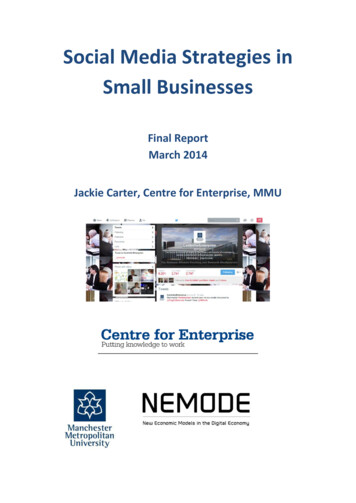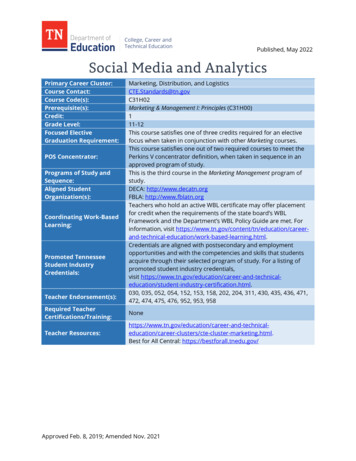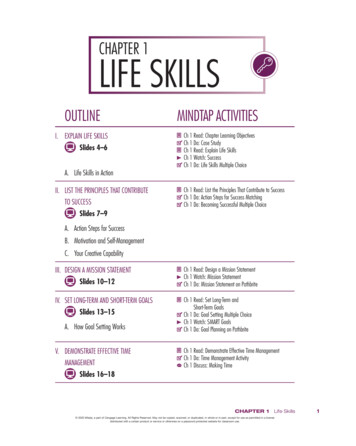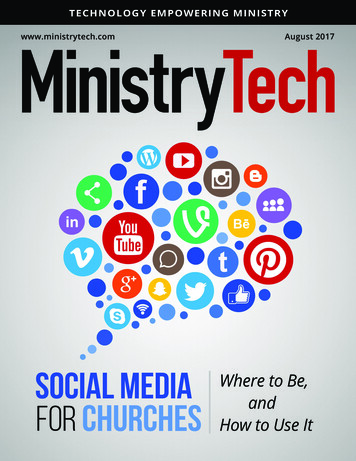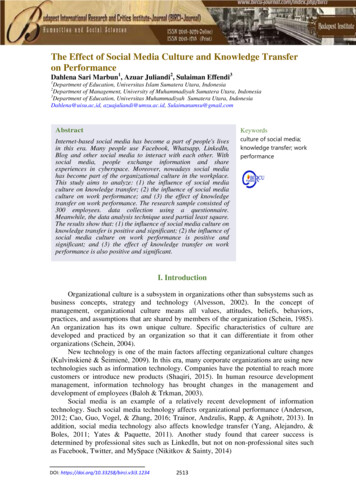
Transcription
The Effect of Social Media Culture and Knowledge Transferon PerformanceDahlena Sari Marbun1, Azuar Juliandi2, Sulaiman Effendi31Department of Education, Universitas Islam Sumatera Utara, IndonesiaDepartment of Management, University of Muhammadiyah Sumatera Utara, Indonesia3Department of Education, Universitas Muhammadiyah Sumatera Utara, IndonesiaDahlena@uisu.ac,id, azuajuliandi@umsu.ac.id, sed social media has become a part of people's livesin this era. Many people use Facebook, Whatsapp, LinkedIn,Blog and other social media to interact with each other. Withsocial media, people exchange information and shareexperiences in cyberspace. Moreover, nowadays social mediahas become part of the organizational culture in the workplace.This study aims to analyze: (1) the influence of social mediaculture on knowledge transfer; (2) the influence of social mediaculture on work performance; and (3) the effect of knowledgetransfer on work performance. The research sample consisted of300 employees. data collection using a questionnaire.Meanwhile, the data analysis technique used partial least square.The results show that: (1) the influence of social media culture onknowledge transfer is positive and significant; (2) the influence ofsocial media culture on work performance is positive andsignificant; and (3) the effect of knowledge transfer on workperformance is also positive and significant.culture of social media;knowledge transfer; workperformanceI. IntroductionOrganizational culture is a subsystem in organizations other than subsystems such asbusiness concepts, strategy and technology (Alvesson, 2002). In the concept ofmanagement, organizational culture means all values, attitudes, beliefs, behaviors,practices, and assumptions that are shared by members of the organization (Schein, 1985).An organization has its own unique culture. Specific characteristics of culture aredeveloped and practiced by an organization so that it can differentiate it from otherorganizations (Schein, 2004).New technology is one of the main factors affecting organizational culture changes(Kulvinskienė & Šeimienė, 2009). In this era, many corporate organizations are using newtechnologies such as information technology. Companies have the potential to reach morecustomers or introduce new products (Shaqiri, 2015). In human resource developmentmanagement, information technology has brought changes in the management anddevelopment of employees (Baloh & Trkman, 2003).Social media is an example of a relatively recent development of informationtechnology. Such social media technology affects organizational performance (Anderson,2012; Cao, Guo, Vogel, & Zhang, 2016; Trainor, Andzulis, Rapp, & Agnihotr, 2013). Inaddition, social media technology also affects knowledge transfer (Yang, Alejandro, &Boles, 2011; Yates & Paquette, 2011). Another study found that career success isdetermined by professional sites such as LinkedIn, but not on non-professional sites suchas Facebook, Twitter, and MySpace (Nikitkov & Sainty, 2014)DOI: https://doi.org/10.33258/birci.v3i3.12342513
Budapest International Research and Critics Institute-Journal (BIRCI-Journal)Volume 3, No 3, August 2020, Page: 2513-2520e-ISSN: 2615-3076 (Online), p-ISSN: 2615-1715 : birci.journal@gmail.comBased on these important reasons, this study aims to examine how social mediaculture affects knowledge transfer; social media culture in influencing work performance;and knowledge transfer in influencing knowledge transfer.II. Review of LiteratureThe main issue in this paper is social media culture. Organizational culture is thevalues and special characteristics in an organization (Schein E. H., 1985; Schein E. H.,2004). Currently, social media is part of organizational culture to achieve employee andcompany performance (Shaqiri, 2015; Baloh & Trkman, 2003; Anderson, 2012; Cao, Guo,Vogel, & Zhang, 2016; Trainor, Andzulis, Rapp, & Agnihotr. , 2013).Social media and social networking are two different terms. Social networking sitesas web-based services that allow individuals to create public profiles and share connectionswith others in an interconnected system (Boyd & Ellison, 2007).Meanwhile, social media is a broader term. Social media is a web-based platformthat allows workers to communicate messages to specific co-workers or broadcastmessages to everyone in an organization, including sharing information files with eachother with anyone and at any time within their organization (Leonardi, Huysman, &Steinfield , 2013). Social media is quite diverse, including collaborative projects, microblogs, blogs, content communities, social networking sites, virtual games, and virtualsocial worlds (Kaplan, 2012; Kietzmann, Hermkens, McCarthy, & Silvestre, 2011). Socialmedia like that, has been studied a lot by scientists.In general, research shows that information technology and the internet have createda new business model (Shaqiri, 2015) and transformed staff and human resourcedevelopment management (Baloh & Trkman, 2003). In particular, many studies haveexamined the relationship between social media, knowledge transfer and performance.First, the study of social media relations and knowledge transfer. One of the findings ofthis study is that social media facilitates the transfer of knowledge and work performance(Cao, Guo, Vogel, & Zhang, 2016). In other research, social media technology allows fortacit and explicit transfer of knowledge (Murphy, 2013). This can occur because thetransfer of knowledge is made easier by social networking sites (Leonardi & Meyer, 2015).III. Research MethodThis research involves qualitative research method. As explained by Creswell (1998:15) that Qualitative research is an inquiry process of understanding based on detailedscientific traditions of inquiry that explore a social or human problem. The researcherbuilds a complex, holistic picture, analyzes words, reports detailed views of informants,and conducts the study in a natural setting. Whatever the approach used is a naturalisticapproach because the research is done in natural conditions (natural settings) or on naturalobjects. Natural objects are objects that develop as they are not manipulated by researchersand the presence of researchers does not change the dynamics of these objects (Sugiyono,2011: 14).The data analysis technique uses interactive model analysis. Because it is consideredmore appropriate to meet the requirements in conducting data analysis. Interactive analysisconsists of three activities that occur simultaneously, namely: data reduction, presentation2514
data and drawing conclusions / verification (Miles and Huberman, 1992: 16).Second, studies on social media relations and work performance. One study foundthat social media is influenced by work performance (Cao, Guo, Vogel, & Zhang, 2016).Other research findings confirm that there is an important relationship between social mediause and work performance (Leftheriotis & Giannakos, 2014). Other studies have also proventhat the interactive effects of using social media are positively related to customerrelationship performance (Trainor, Andzulis, Rapp, & Agnihotr, 2013).Third, studies on the relationship between knowledge transfer and work performance.Knowledge has become an attractive key in the information revolution. Choosing the rightinformation from multiple sources and turning it into useful knowledge is a major challenge(Smith, 2001). Organizations that are able to transfer knowledge effectively from one unit toanother more productively are more likely to survive than those less adept at transferringknowledge (Argote, Ingram, Levine, & Levine, 2000). One study has found that partneringknowledge and experience leads to increased performance (Makino & Delios, 1996). Anotherdifferent study shows that openness in communication is considered to have a positiveinfluence on employee knowledge sharing, which in turn improves individual workperformance (Kang, Kim, & Chang, 2008).The conclusions of the above studies are that there is a positive influence of socialmedia culture on knowledge transfer; social media culture on work performance; also thetransfer of knowledge on job performance. The relationships shown in Figure 1.Culture ofsocial mediaWorkperformanceKnowledgetransferFigure 1. Conceptual frameworkThe approach in this study is survey research. Research respondents consisted of 100educators (teachers) and 200 government employees (a total of 300 people) in Medan City,Indonesia. The research variables consisted of social media culture as an exogenous variable;knowledge transfer as a mediating variable, and work performance as an endogenousvariable.Measurement of these variables uses instruments adopted from various relevantstudies. First, the culture of using social media uses indicators: frequency of using socialmedia, obtaining information, building trust, sharing visions, and strengthening networks(Cao, Guo, Vogel, & Zhang, 2016). Second, transfer of knowledge. The indicators are: Formof knowledge transferred, Mechanism of knowledge transfer, Success of knowledge transfer(Smale, 2008). Third, work performance. Indicators to measure work performance are newknowledge, increased skills / skills, changes in values, changes in behavior, improvements inconditions, and changes (Hatry, 2006).The data analysis technique for this study uses partial least square as one of thestructural equation modeling methods. Research data processing utilizes SmartPls (Ringle,Wende, & Becker, 2015). The partial least square model used is the Reflective model. Thismodel depicts a pattern in which arrows originate from the latent variable leading to itsindicators (Figure 2).2515
3CSM-1Figure 2. Reflective model dari partial least squareIV. DiscussionThis section describes four sections, including: (1) the demographics of therespondents, (2) assessing the measurement model; (3) assessing the structural model; and (4)discussion, implications and limitations.4.1. Respondents DemographyDemographic characteristics of respondents are shown in Table 1. There are fourcharacteristics that need to be known, namely gender, age, education and type oforganization.Table 1. Demographic characteristic of respondentsMeasureGenderMaleFemaleAge 2121-3031-4041-50 51EducationHigh schoolDiplomaBachelorMasterDoctorateOrganizational 007.3333.3338.334.0010020033.3366.674.2. Assessing the Measurement Model (Outer Model)Assessing the measurement model aims to evaluate the relationship betweenindicators and latent variables.The first measurement model is to test the convergent validity seen from the value ofouter loadings. Each indicator is expected to have an outer value greater than 0.4, especially2516
for relatively new exploratory studies. However, the outer loading value is very low, which isless than 0.40, so the indicator must be removed from the variable and re-tested forconvergent validity (Hair, Hult, Ringle, & Sarstedt, 2014). All outer loading values aregreater than 0.4 (Table 2). Thus, all latent variables have good convergent validity.Table 2 Outer .780.811.695.717.569.589.668.595The second measurement model is to test the construct reliability and validity. Thismeasurement refers to the composite reliability value which must be greater than 0.6(Bagozzi and Yi, 1988; Chin & Dibbern, 2010). The measurement results show that all latentvariables have a fairly good composite reliability value because they are greater than 0.6(Table 3).Table 3 Construct reliability and validityComposite ReliabilityCSM.820KT.812WP.806The third measurement model looks at the results of discriminant validity. Thereference is to look at the latest measurement criteria from discriminant validity, namelylooking at the Heretroit-Monotrait Ratio (HTMT) value. If the HTMT value is less than 0.90then a construct has good discriminant validity (Henseler, Ringle, & Sarstedt, 2015).Table 4 Discriminant validityHeterotrait-Monotrait Ratio (HTMT)CSMKTWPCSMKT.607WP.358.4134.3. Assessing the Structural Model (Outer Model)In measuring the structural model, the first step is to test the R-Square. R2 value 0.75 (model is substantial); R2 0.50 (the model is moderate); and R2 0.25 (model isweak) (Hair, Hult, Ringle, & Sarstedt, 2014; Henseler, Ringle, & Sinkovics, 2009). The RSquare value of 0.185 shows that the ability of social media cultural variables to explainknowledge transfer is weak. Likewise, the R-Square value of 0.142 indicates that the ability2517
of social media culture variables and knowledge transfer to explain work performance is alsoweak.Table 5 R-SquareR SquareR Square AdjustedKT.185.182WP.142.137The second stage in measuring the structural model is testing the hypothesis, namely:the direct influence of social media culture on knowledge transfer; direct influence of socialmedia culture on work performance; direct effect of knowledge transfer on job performance;and the indirect influence of social media culture on work performance that is mediated byknowledge transfer (Table 6).Table 6 Path coefficients (direct effects)Direct EffectsIndirect EffectsTotal EffectsCSM - KTCSM - WPKT - WPCSM - KT - WPOriginalSample(O).430.197.248.106.304Sample ).054.067.063.031.063T Statistics( O/STDEV 000Figure 2. Result of partial least square analysis for R-square interpretationThe test results show that: (1) the influence of culture of social media on knowledgetransfer is positive (0.43) and significant (0.000); (2) the influence of culture of social mediaon work performance is positive (0.197) and significant (0.003); and (3) the effect ofknowledge transfer on work performance is positive (0.248) and significant (0.000); (4). Theinfluence of culture of social media on work performance is not mediated by knowledgetransfer (direct effects CSM - WP 0.197 are greater than indirect effects CSM KT WP 0.106) (Table 6).4.4. Discussion, Implications And LimitationThis research has investigated the relationship between social media culture andknowledge transfer; social media culture and work performance; and transfer of knowledgeand work performance.This study found that there is a positive and significant influence between socialmedia culture and knowledge transfer. This means that if social media is part of theorganizational culture it will facilitate increased knowledge transfer. This finding is relevantto previous studies such as Shaqiri (2015); Baloh & Trkman (2003); Cao, Guo, Vogel, &Zhang (2016); and Leonardi & Meyer (2015).A positive and significant influence also occurs on the relationship between socialmedia culture and work performance. If the social media culture in work organizationsbecomes a culture, it will have an impact on improving work performance. Research findingsby Cao, Guo, Vogel, & Zhang (2016); Leftheriotis & Giannakos (2014); Trainor, Andzulis,Rapp, & Agnihotr (2013) support the findings of this study.Previous research from Smith (2001); Argote, Ingram, Levine, & Levine (2000);Makino & Delios (1996); and Kang, Kim, & Chang (2008) are relevant to this study, because2518
the relationship between knowledge transfer and job performance produces a positive andsignificant value.Based on the findings of this study, the authors suggest organizational management tobuild a social media culture in their organization. With social media, organizational memberswill easily exchange information about work knowledge to achieve the goal of improvingwork performance.This study has several limitations. First, the R-Square measurement shows that thisresearch model is weak. The next research is expected to produce a more substantial (strong)model. The second limitation, the scope of this research area only analyzes workers in onecity. At least the next research needs to study a wider area, namely one country.V. ConclusionIn the era of information technology, organizational management must understand theculture of social media in the workplace. As the findings of this study, culture of social mediais known to affect knowledge transfer and work performance, likewise knowledge transferaffects work performance.Thus, management must rearrange its strategies for human development focusing oninformation technology. A culture of sharing knowledge using social media will increase theknowledge and skills of workers. The consequences of ignoring reality will hinder futureorganizational achievements.ReferencesAlvesson, M. (2002). Understanding organizational culture. London: Sage Publications.Anderson, C. (2012). The impact of social media on lodging performance. Cornell UniversitySchool of Hotel Administration , 12 (15), 6-11.Argote, L., Ingram, P., Levine, J. M., & Levine, J. M. (2000). Knowledge transfer inorganizations: Learning from the experience of others. Organizational Behavior andHuman Decision Processes , 82 (1), 1-8.Bagozzi, R. P., & Yi, Y. (1988). On the evaluation of structural equation models. Journal ofthe academy of marketing science, 16(1), 74-94.Baloh, P., & Trkman, P. (2003). Influence of internet and information technology on workand human resource management. Informing Science & IT Education Conference (pp.498-505). California: Informing Science Institute.Boyd, D. M., & Ellison, N. B. (2007). Social network sites: Definition, history, andscholarship. Journal of Cimputer-Mediated Communication , 13(1), 210–230.Cao, X., Guo, X., Vogel, D., & Zhang, X. (2016). Exploring the influence of social media onemployee work performance. Internet Research , 26(2), 529-545.Chin, W. W., & Dibbern, J. (2010). An introduction to a permutation based procedure formulti-group PLS analysis: Results of tests of differences on simulated data and a crosscultural analysis of the sourcing of information system services between Germany andthe USA. In V. E. Vinzi, W. W. Chin, J. Henseler, & H. Wang (Eds.), Handbook ofpartial least squares: Concepts, methods and applications. Verlag Berlin Heidelberg:Springer.Hair, J. E., Hult, G. M., Ringle, C. M., & Sarstedt, M. (2014). A primer on partial leastsquares structural equation modeling ( PLS-SEM). Los Angels: SAGE Publications.2519
Henseler, J., Ringle, C. M., & Sinkovics, R. R. (2009). The use of partial least squares pathmodeling in international marketing. Advances in International Marketing, 20. 277320.Henseler, J., Ringle, C. M., & Sarstedt, M. (2015). A new criterion for assessing discriminantvalidity in variance-based structural equation modeling. Journal of the academy ofmarketing science, 43(1), 115-135.Kang, Y.-J., Kim, S.-E., & Chang, G.-W. (2008). The impact of knowledge sharing on workperformance: An empirical analysis of the public employees' perceptions in SouthKorea. International Journal of Public Administration , 31 (14), 1548-1568.Kaplan, A. M. (2012). If you love something, let it go mobile: mobile marketing and mobilesocial. Business Horizons , 53 (1), 129-139.Kietzmann, J. H., Hermkens, K., McCarthy, I. P., & Silvestre, B. S. (2011). Social media?Get serious! Understanding the functional building blocks of social media. BusinessHorizons , 54 (3), 241–251.Kulvinskienė, V. R., & Šeimienė, E. S. (2009). Factors of organizational culture change.Ekonomika , 87 (1), 27-43.Leftheriotis, I., & Giannakos, M. N. (2014). Using social media for work: Losing your timeor improving your work? Computers in Human Behavior , 31 (1), 134–142.Leonardi, P. M., & Meyer, S. R. (2015). Social Media as Social Lubricant: How AmbientAwareness Eases Knowledge Transfer. American Behavioural Scientist , 59 (1), 10-34.Leonardi, P. M., Huysman, M., & Steinfield, C. (2013). Enterprise social media: Definition,history, and prospects for the study of social technologies in organizations. Journal ofComputer-Mediated Communication , 19 (1), 1–19.Makino, S., & Delios, A. (1996). Local Knowledge Transfer and Performance: Implicationsfor Alliance Formation in Asia. Journal of International Business Studies , 27 (5), 905–927.Murphy, G. (2013). Using social media to facilitate knowledge transfer in complexengineering environments: A primer for educators. European Journal of EngineeringEducation , 38 (1), 70-84.Nikitkov, A., & Sainty, B. (2014). How significant are users’ opinions in social media?International Journal of Accounting & Information Management , 22 (4), 273-294.Ringle, C.,Wende, W. S., & Becker, J. M. (2015). SmartPLS 3. Boenningstedt: SmartPLSGmbH.Schein, E. H. (1985). Organizational culture and leadership. Sanfransisco CA: Jossey Bass.Schein, E. H. (2004). Organizational culture and leadership. San Francisco: Jossey-Bass,John Wiley & Sons.Shaqiri, A. B. (2015). Impact of information technology and internet in businesses. AcademicJournal of Business, Administration, Law and Social Sciences , 1 (1), 73-79.Smith, E. A. (2001). The role of tacit and explicit knowledge in the workplace. Journal ofKnowledge Management , 5 (4), 311 - 321.Trainor, K. J., Andzulis, J. M., Rapp, A., & Agnihotr, R. (2013). Social media technologyusage and customer relationship performance: A capabilities-based examination ofsocial CRM. Journal of Business Research , 67 (6), 1201-1208.Yang, J., Alejandro, T. G., & Boles, J. S. (2011). The role of social capital and knowledgetransfer in selling center performance. Journal of Business & Industrial Marketing , 26(3), 152 - 161.Yates, D., & Paquette, S. (2011). Emergency knowledge management and social mediatechnologies: A case study of the 2010 Haitian earthquake. International Journal ofInformation Management , 31 (1), 6-11.2520
knowledge transfer as a mediating variable, and work performance as an endogenous variable. Measurement of these variables uses instruments adopted from various relevant . CSM TK CSM-1 CSM-1 CSM-1 CSM-1 CSM-1 TK-1 TK-2 TK-3 WP WP-1 WP-2 WP-3 . 2517 for relatively new exploratory studies. However, the outer loading value is very low, which is






